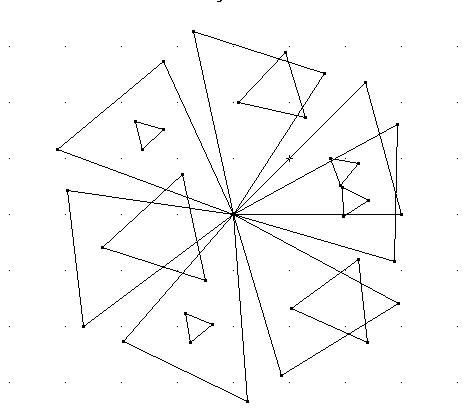Then the triangle MNP is equilateral.
Morley's theorem:
For an arbitrary triangle ABC one draws the
trisector lines of angles at
A,
B, C. Then the two trisector lines at B and C which are
closer to the side a intersect at point M. In an analogous
way one determines points N and
P.
Then the triangle MNP is equilateral.
A set of DERIVE functions which give the Morley's triangle of a given triangle.
Experimenting with this beautiful theorem:
Sometimes strange phenomena happen with the experiments. It would seem then in every case this equilateral triangle should be in the interior of the initial triangle, but...
We experiment by rotating the same triangle
around one of its vertices
The reason?
The DERIVE function ATAN gives us values between -p/2 and p/2. For this reason the program was producing sometimes the trisector lines interior to the angles at A, B, C and some other times the trisector lines of the exterior angles.
To confirm this point one can make
an easy experiment with DERIVE.
Changing the function ATAN so that it gives us values between 0 and p we obtain the following 'Morley' triangles:with new ATAN with old ATAN

But... the triangles which result seem to keep being equilateral.
Perhaps a different new theorem behind?
One can choose the trisector lines for the three
external angles.
The resulting triangle is equilateral.
W.R. Spickerman, An extension of Morley's theorem,
Math. Magazine 44 (1971) 191-192.
One can also choose the trisector lines for two internal
angles and the ones for the other external third angle.
The resulting triangle is equilateral. The proof can
follow the same pattern as in the other cases.
One also can observe that all the 5 equilateral 'Morley'
triangles have sides which are parallel, i.e. there are just three directions
for all the sides. It is easy to measure the inclination over the sides
of the original triangle.
(New?) Anyway the bright idea belongs to Morley.